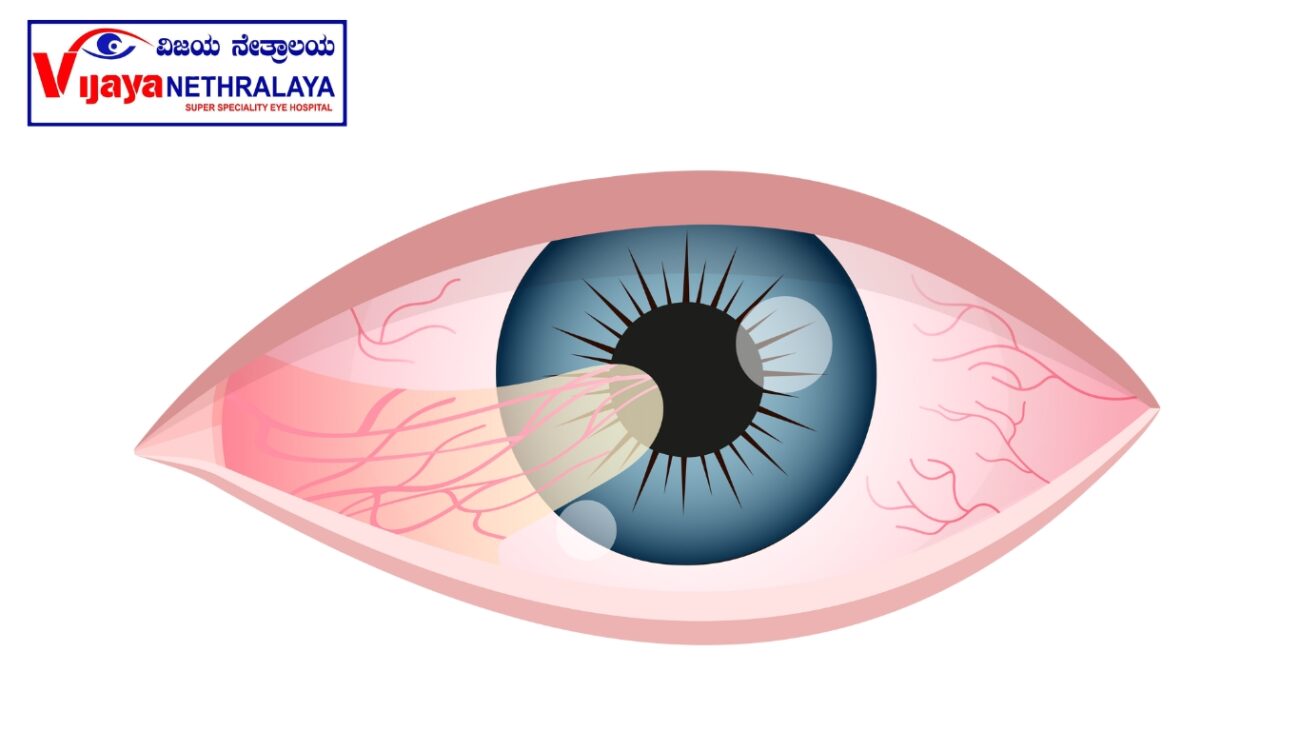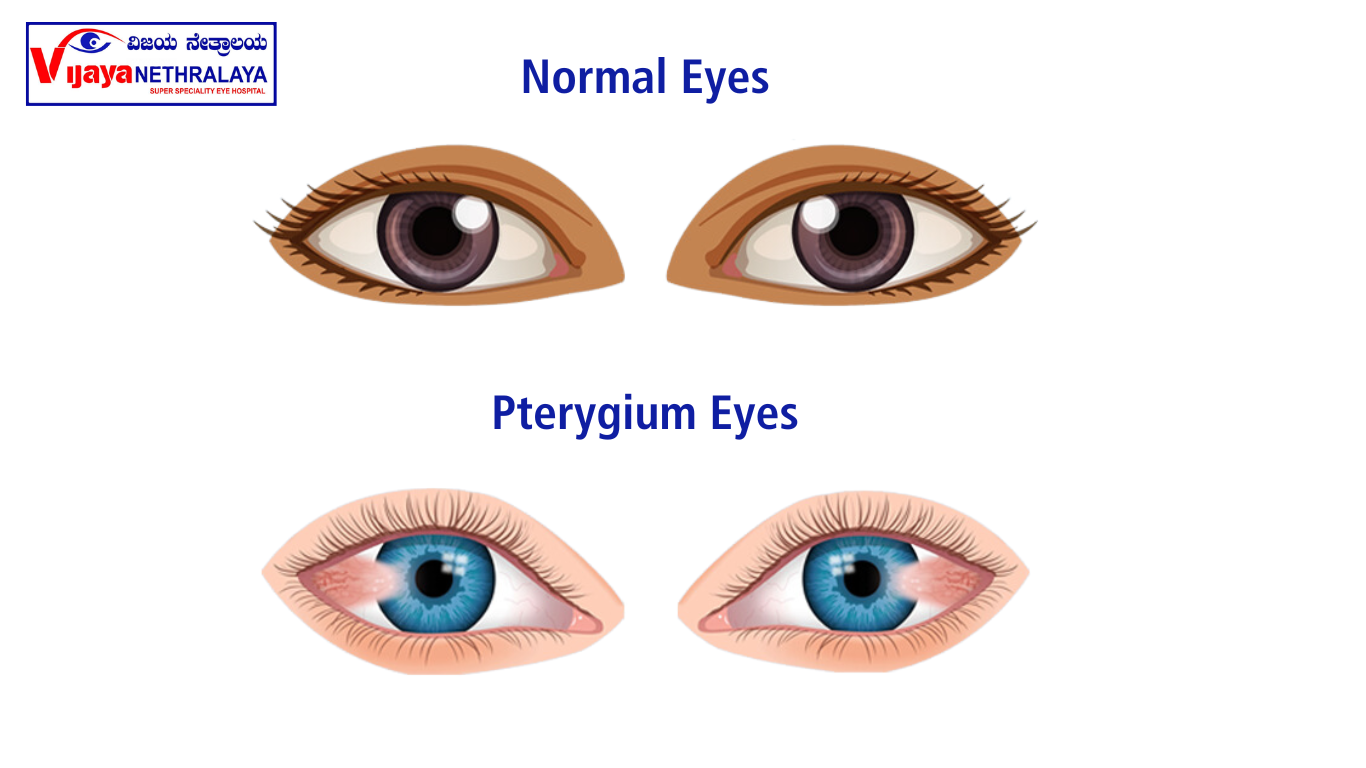What is a pterygium?
A pterygium is a raised, yellowish, wing-shaped thickening on the white part of the eye, which can spread over the cornea, obstructing vision. The term Pterygium means wing-shaped. It is a degenerative wear and tear change of the surface of the eye, which results in growth of conjunctival tissue (from the white of the eye) across the cornea (the clear window through which we see). The pterygium is red, fleshy, and thickened in comparison with the normal conjunctiva.

Causes Of Pterygium:
The exact cause remains unknown, but experts associate it with excessive exposure to wind, sun, or sand.
People who live in hot dusty climates or have worked outdoors for many years or have experienced temperature fluctuations commonly exhibit this condition.
It may be due to drying of the eye. It is not a tumor or cancer, but it can get slowly larger with time.
Several studies have found that higher rates of pterygium are associated with older age.
It is uncommon for patients to present with pterygium prior to age 20 years.
Males are reported to experience pterygium twice as frequently as females.
Symptoms Of Pterygium:
In the initial stages, there may not be any symptoms. But one may observe a mass in the eye.
They can be uncomfortable, often causing dryness or foreign-body sensation in the eye.
Some may experience redness and inflammation.
Most seriously, they may cause reduction in vision, either by inducing astigmatism (change in the shape of the eye) and irregularity of the cornea or by physically obstructing vision.
Treatment Of Pterygium:
If the pterygium is small and does not cause any symptoms, there is no requirement for treatment.
Artificial tears often alleviate symptoms of dryness, foreign-body sensation, and discomfort.
Medical treatments are for symptomatic relief and have not been shown to stop progression or cause regression of a pterygium. Definitive treatment is achieved only by surgical removal.
Indications for surgical removal of pterygium include:
-Opacity in the visual axis
-Astigmatism leading to decreased vision
-Documented growth that is threatening to affect the vision
-Restriction of eye movement
-Significant cosmetic impact or intractable irritation
How is the pterygium surgery done?
This is usually performed under local anesthesia as a day case in the operating theatre.
You can eat and drink normally before the operation.
- The eye will be numbed using drops and an injection.
- An eye speculum will be used to hold the eyelids open during the procedure.
- The surgeon will carefully scrape off the pterygium from both the cornea and the sclera.
- A piece of conjunctival autograft will be harvested from another site in the same eye or the fellow eye.
- The harvested graft will be placed over the exposed area to cover it.
- The graft will be secured in place using glue or absorbable sutures.
- The absorbable sutures will naturally fall off or be absorbed within a few weeks.
- After the procedure, the eye will be covered with a protective pad.
Recovery after pterygium surgery:
For the first one or two days after the surgery, the eye may be painful. As a result, this condition often manifests as a scratchy, itchy, foreign body sensation for 1 to 2 weeks.
The eye will be red and swollen over the surgical area for several weeks, settling over about 3 months.
Antibiotic eyedrops are prescribed to prevent infection, and steroid eyedrops are used to help reduce inflammation.
Use eye drops or ointment as prescribed by your doctor.
Furthermore, the use of these medications may last for 2-3 months or more.
Do not rub your eyes. Avoid contact sports and refrain from washing your hair in the first week after the operation, avoid inadvertent contact with dirty water, or foreign body, or trauma to the operated eye.
What are the risks of Pterygium surgery?
Infection: This may occur but can usually be treated with antibiotics eye drops.
Recurrence: A pterygium may recur in up to 10% (1 in 10) cases, usually within the first year after surgery. Repeat surgery may be required
Graft failure: In a few patients (approximately 5% (1 in 20)) there may be problems with the conjunctival graft, including failure of the tissue to establish itself in the new site and separation or loosening of stitches. Further surgery may be necessary.
Author details:
Dr. Sinchana Adyanthaya is a dedicated ophthalmologist with a wide range of experience. She has excelled in routine OPD work, managed high-volume OPDs, and performed various eye procedures. Her fellowship in Cornea and Refractive Surgery has enhanced her skills in advanced corneal investigations and surgeries. Dr. Adyanthaya has published research articles, presented at conferences, and actively participated in academic activities. With her proficiency in multiple languages, she ensures effective communication with patients.



1xbet промокод